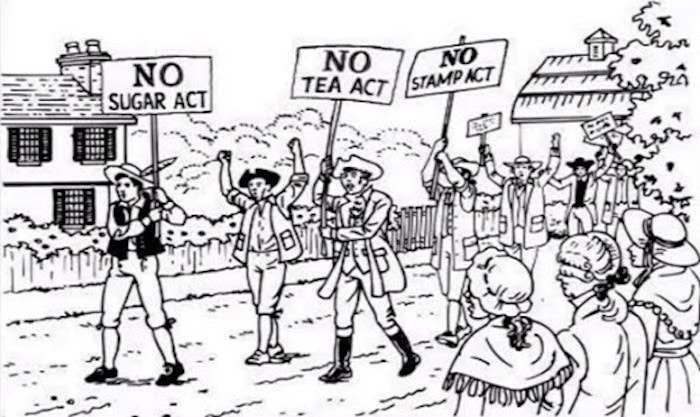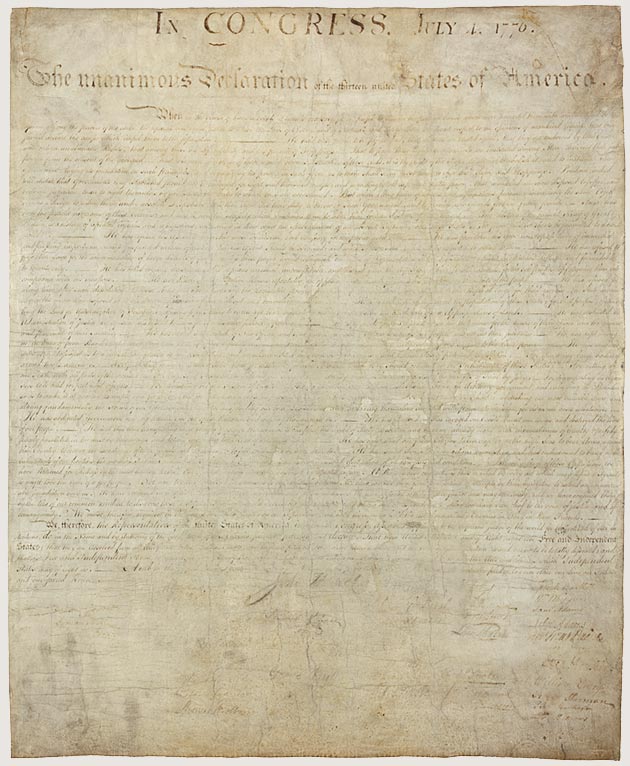
The Tea, Stamp, and Sugar Acts all angered the colonists because they were passed without the colonists being represented in the discussion.
The Declaration of Independence was adopted by the newly formed United States on July 4th, 1776. This document was drafted by five delegates appointed to the task by the Continental Congress. It was finally adopted once fifty-six signers from across the colonies ratified it. They could do this once twelve of the thirteen colonies voted in favor of it. The main purpose of the Declaration was to declare the colonist’s right to freedom from British rule and establish the colonies as a nation. To truly understand the document, we must go back to 1773. During this time the colonies were peaceful and felt as if they were being properly treated. However, as the years went by until July 4th, 1776, the colonists felt the British were treating them unfairly. British policies such as the Tea and Stamp Act taxed colonists’ goods without considering the effects it would have on the colonists. Heavy monitoring of the colonies by the British also made many colonists uneasy. Overall, one phrase rang very loudly throughout this time “No taxation without representation”[1]. This essentially meant that the British shouldn’t enact any law affecting colonists without consulting them. This would eventually lead to the document’s creation and the United States becoming a nation.

The Declaration of Independence uses the words “we” 10 times, “them” 11 times, “us” 6 times, and “he” 19 times.
Besides knowing that the Declaration of Independence established the United States as a nation, we must also look deeper into the document itself to understand its impact. The first thing we notice is the artistic decisions the writers made while drafting the document. The document carefully chooses to include “personal pronouns such as “we”, “them”, “us”, and “he””[2]. This personalizes the conflict between the British and Americans. The significance of this is that the conflict became based on moral grounds about the fair treatment of humans. The British now knew they were personally attacking the citizens, not the colonies. The declaration also encourages readers to identify and align themselves with the colonists and Congress. They wanted to share a sense of being the victim across the entire country to foster more support. Lastly, during the indictment of King George III, the drafters realized they needed concrete proof to accomplish this task. They accomplish this beautifully by starting with the phrase “To prove this”[2]. This shows us that the upcoming information demonstrates that King George III is a tyrant. The target audience of this information is what they call the “candid world”[2]. This refers to readers who have no bias and are fair, impartial, and just. The idea is that any such reader will see the evidence as perfect proof that the king attempted to establish absolute and complete tyranny in America.
After touching upon the artistic decisions, we must now finally dive into the lasting effects the declaration had on law and the effects around the world. In the context of how to interpret the law in our country, no one says it better than Carlton F.W. Larson. They say, “The Declaration was not, as is often asserted, a declaration of thirteen states declaring their individual independence. Rather, it was the declaration of one American people declaring the existence of one American nation. It is therefore entirely appropriate to date the legal existence of the American nation from July 4, 1776, and not from the date of the Articles of Confederation or of the ratification of the Constitution.”[3] Using this information, we can destroy a misconception that many Americans have learned. We can even use this quote to establish community in the states since the states didn’t obtain independence, the American community did. This also helps lawmakers look at the history of American law by having a “concrete starting date”[3]. We can also look at its implications on politics in the modern world. The declaration’s biggest effect is that it would “influence the independency of future nations”[4]. With America overcoming the superpower, Britain, it gave many other colonies and oppressed countries the courage to take the matter into their own hands and fight for independence.
Overall, the Declaration of Independence wasn’t just a sheet of paper. It was a document that would change the course of the colonist’s history. Looking back on it now we can see it affects us today in our laws and many other areas. The document even helped other countries find their freedom. The Declaration of Independence is the single most important document in American history for a good reason.
[1] David Emory Shi. America: A Narrative History (Brief Twelfth Edition). 12th ed. Vol. 1. 2 vols. W.W. Norton and Company (W. W. Norton & Company), 2022.
[2] Stephen E Lucas. “The Stylistic Artistry of the Declaration of Independence.” National Archives and Records Administration, Spring 1990. https://www.archives.gov/founding-docs/stylistic-artistry-of-the-declaration Accessed June 18th, 2020
[3]Carlton F.W. Larson. The Declaration of Independence: A 225th Anniversary ReInterpretation. 3rd ed. Vol. 76. Seattle, Washington: Washington Law Review, 2001. https://digitalcommons.law.uw.edu/cgi/viewcontent.cgi?article=4342&context=wlr. Accessed June 18th, 2020
[4]David Armitage. “The Declaration of Independence: A Global History.” Cambridge, Mass.: Harvard University Press, 2007. Google Books, https://books.google.com/books?hl=en&lr=&id=RHlYssMw6oUC&oi=fnd&pg=PA1&dq=declaration%2Bof%2Bindependence&ots=JAvrxUsqRm&sig=yre0R0c-Y4uNmikgfY5zeR7iNWM#v=onepage&q=declaration%20of%20independence&f=false. Accessed June 17, 2023
